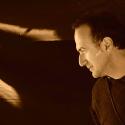Squash! Bulldoze! Blow-Up! Tie Up! Break-Up! Re-Build! There is practically nothing the artist Cornelia Parker won’t and can’t do with found materials, offcuts, the discarded and the recycled, not to mention tieing up Rodin’s The Kiss at the Tate in miles of string.
Since she discovered bulldozer drivers like nothing better than bulldozing, she has been practically unstoppable. That DANGER! sign can be all too true when she is blowing something up, although found materials have included two small wooden American churches, one hit by lightning, and the other torched by racist biker gang arsonists.
Her father made her follow the masculine pursuits, acting as the son he had always wanted
At the beginning of an artist residency in Texas, Parker collected all the bits: the naturally burnt church became Mass (Parker was brought up a Catholic, losing her faith when she was an adolescent) and the church destroyed through malice, AntiMass. Their black burnt fragments reassembled into airy suspensions, both are now museum pieces. And did we say she married a Texan, and naturally the wedding venue was Brooklyn Bridge?
Yet again Alan Yentob, in an exhaustive mini-documentary plus interview, has presented a show-and-tell with one of our most inventive and surprising artists. In keeping with the newly minted ascendancy of females in all walks of professional life, it is Cornelia Parker stepping out onto the international stage. As Iwona Blazwick, director of the Whitechapel Art Gallery, accurately said, there is no artist like her: truly original, inventive, surprising, historically alert, amusing.
Marcel Duchamp is an inspiration, and Parker is an inveterate collaborator, even deploying explosive experts from the army as the facilitators for the first work of art which drew media attention: Cold Dark Matter: An Exploded View, 1991. Parker’s collaborators obligingly blew up a conventional garden shed, complete with its contents; reassembled as a floating series of fragments suggesting the original, it is now owned by the Tate, and remains an iconic and haunting work of art.
Yentob was sympathetic, at times a bit sycophantic – no hard questions here about finance, for instance. Parker herself is an unusually attractive interviewee: tall, dressed in black, reddish hair in a disarming pudding bowl haircut, she responded without guile and with a quiet calm when Yentob turned cod psychoanalyst. She's the middle daughter born to a Cheshire farmer and a young traumatised German woman, a nurse in the Luftwaffe and then a prisoner of war, who while still in Germany bartered her one possession, a beloved watch, to avoid physical assault. The maternal past was never spoken of.
Her father made her follow masculine pursuits, acting as the son he had always wanted. She learned to use her hands, took to art at school, and in order to get over her fear of rushing trains, put coins on the track to be crushed, initiating a life-long interest in crushing one thing in order to make it into another. She tended to disappear from farm chores when she could, up trees for example; and the subsequent career of this shy tomboy is partly predicated on doing things she wasn’t allowed to do as a child. Along the way she talked of duality, malign/benign, dark/light.
 This summer Ms Parker has done nothing less than build, with the aid of Showman Fabricators, a New York company that makes theatre sets, a house in the rooftop garden of the Metropolitan Museum of Art, New York, looking out over skyscrapers and Central Park (pictured above). This commission offers the most prestigious site-specific location for a temporary, contemporary work of sculpture and provided the hook for the programme.
This summer Ms Parker has done nothing less than build, with the aid of Showman Fabricators, a New York company that makes theatre sets, a house in the rooftop garden of the Metropolitan Museum of Art, New York, looking out over skyscrapers and Central Park (pictured above). This commission offers the most prestigious site-specific location for a temporary, contemporary work of sculpture and provided the hook for the programme.
Yentob accompanied Parker on a road trip in New England as she settled on something to do with the iconic archetype of rural America: the red barn. That characteristic red colour is evidently made by using rust, or animal blood, mixed with linseed oil. But the red barn was too blandly comforting. On to Alfred Hitchcock, a British master of terror, horror and Hollywood: and the house became reminiscent of the house in Psycho, home to terrible events, and a house, it turns out, inspired by Edward Hopper’s haunting painting of... a house.
For Parker, it inspired Transitional Object (PsychoBarn), recreated from a fragmented red barn with embellishment: a 30-foot high stage-set house, a two-sided façade, propped up internally with invisible scaffolding. Her demurely amiable manner underlined the ways in which her work, based on destruction, leads to a convincing and imaginative reconstruction.















Add comment